- Home
- Technical Cooperation Projects
- Index of Countries
- Middle East
- Egypt
- The Project for the Conservation Center in the Grand Egyptian Museum
- Project News
- Students from Japanese School in Cairo visited the Project
Project News
2012-05-16
Students from Japanese School in Cairo visited the Project
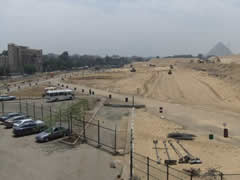 (Photo 1) Construction in Progress
(Photo 1) Construction in Progress
The Project invited 10 students from Grade 5 and 6 (elementary school) and Grade7, 8, 9 (Junior high school) of Japanese School in Cairo to the construction site of the Grand Egyptian Museum (GEM) and GEM Conservation Center (GEM-CC).
The visit was planned to help the students to learn Egyptian history where they live, to understand the importance of cultural heritage preservation and to contribute to education of international understanding through looking closely at mummies, coffins and statues which are parts of the Egyptian cultural heritage and learning about conservation of these artifacts.
Further, the visit was intended to open the opportunity for Japanese students to learn about international cooperation implemented by JICA and to help the students' career plan for their future as they come to meet the Japanese experts working for the Project.
Their visit began from the construction site of GEM. Though the construction has started on 11th March, 2012, it was difficult to imagine the form of the future museum. It was explained to the students how the museums was going to be like and how the Japanese assistance helped the museum project using some visual tools such as image of how the museum's future look (Photo 1). At the construction site, the great statue of the Ramesses II is waiting for the museum opening. The statue which is measured 11 meters high and 35 tons was transported from the Ramesses Square in downtown Cairo in 2006. The students were surprised at the size of the statue and exited to find the ancient scripts written on the back of the statue.
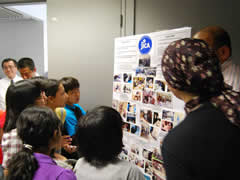 (Photo 2) ADD Manager, Ms. Sara, explained about their work
(Photo 2) ADD Manager, Ms. Sara, explained about their work
Moving to GEM-CC, Yasunori Matsuda expert explained about capacity development carried out by the Project and Tomomi Fushiya expert talked about ancient Egyptian religion related to the artifacts they were going to see at the Conservation labs. Then, they visited the office of ADD and learned how a collection database is built and developed through some photos of ADD's activities (Photo 2)
The students visited Human Remains Lab, Wood Lab and Inorganic labs among other conservation labs. The GEM-CC tour for them was planned to look at artifacts related to ancient Egyptian religion and their image of the afterlife. As they looked at human mummies, beautifully decorated wooden coffins, a colorful mask made of cartonage, ceramic coffins and other related tomb goods, the conservators of GEM-CC explained to them about how to make a mummy, what is "the Book of the Dead" and gods and goddesses of the ancient Egypt (Photo 3, 4, 5).
They also visited the Microbiology lab which researches on microorganism that could damage mummies, organic materials and stone objects. An Egyptian microbiologist taught the Japanese students that there are various kinds of fungi, how to culture and identify them. The students were surprised to find out that something they see in their everyday life such as fungi related to conserving museum artifacts.
Overall, they were very enthusiastic and interested in looking at ancient artifacts so closely without any glass cases. They were always listening carefully and taking notes of what the experts were telling to them. There were many questions from them. Some of the questions were very well-thought and sharp. One of the conservators who answered the questions praised the students that she/he would be a future archaeologist! It was a great and precious opportunity to communicate directly to those who work on artifacts and to learn many different experts working together for conservation.
The students and teachers said at the end that they always thought artifacts and archaeology were only related to social science class. But they found out this day that science was also very important for conservation. Today's conservation work cannot be carried out without a help of science. The Project helps science labs at GEM-CC to cooperate with conservators to work and research with and for conservation.
This year, the Project is going to hold a series of training courses on conservation science. It will help GEM-CC to use the latest technology and research outcomes for conservation.
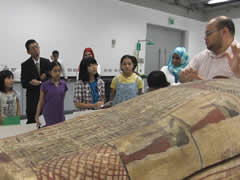 (Photo 3) Carefully listening to the story about an ancient wooden coffin
(Photo 3) Carefully listening to the story about an ancient wooden coffin
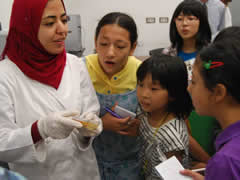 (Photo 4) Feeling scared but looking into the coffin to see a mummy inside
(Photo 4) Feeling scared but looking into the coffin to see a mummy inside
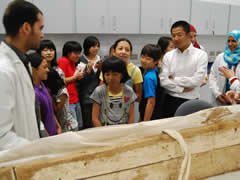 (Photo 5) Looking at the fungi sample, one of them came up with an question, “why fungi in a lunch box stink?”. The Egyptian microbiologist kindly explained their questions one by one.
(Photo 5) Looking at the fungi sample, one of them came up with an question, “why fungi in a lunch box stink?”. The Egyptian microbiologist kindly explained their questions one by one.
- About JICA
- News & Features
- Countries & Regions
- Our Work
- Thematic Issues
- Types of Assistance
- Partnerships with Other Development Partners
- Climate Change / Environmental and Social Considerations
- Evaluations
- Compliance and Anti-corruption
- Science and Technology Cooperation on Global Issues
- Research
- JICA Development Studies Program / JICA Chair
- Support for the Acceptance of Foreign HRs / Multicultural and Inclusive Community
- Publications
- Investor Relations
